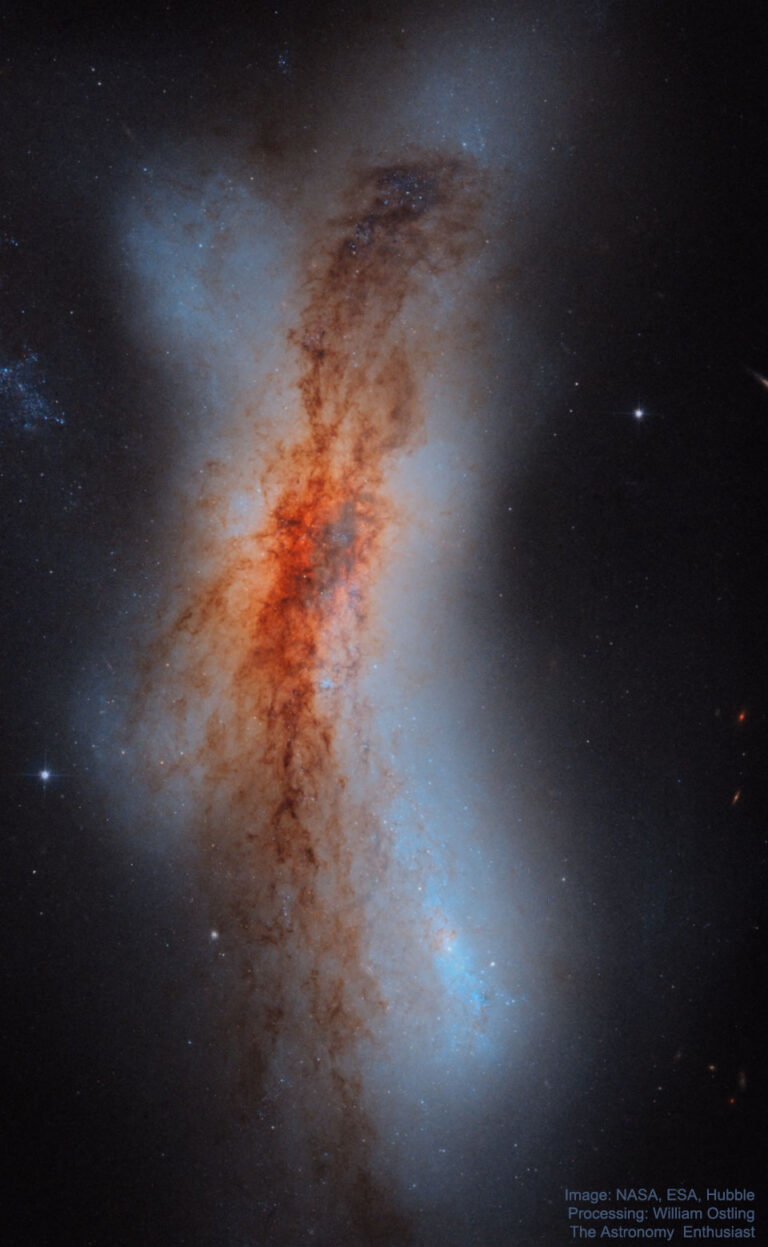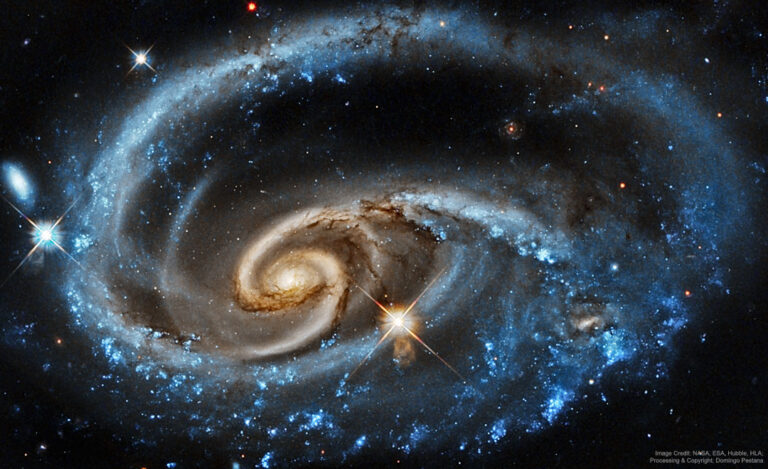NGC 7714: 星系碰撞后的星爆活动
一个蓝色的螺旋星系似乎正在与一个满布尘埃的棕色星系碰撞,并且可能正在穿过这个星系。有关更多详细信息,请参阅说明。

一个蓝色的螺旋星系似乎正在与一个满布尘埃的棕色星系碰撞,并且可能正在穿过这个星系。有关更多详细信息,请参阅说明。

2024年2月7日 The Heart Shaped Antennae Galaxies Image Credit & Copyright: Kent E. Biggs Explanation: Are these two galaxies really attracted to each other? Yes, gravitationally, and the result appears as an enormous iconic heart — at least for now. Pictured is the pair of galaxies cataloged as NGC 4038 and NGC 4039,known as the Antennae Galaxies. Because they are only 60 million light years away, close by intergalactic standards, the pair is one of the best studied interacting galaxies on the night sky. Their strong attraction began about a billion years ago when they passed unusually close to each other. As the two galaxies interact, their stars rarely collide, but new stars are formed when their interstellar gases crash together. Some new stars have already…

2023年10月24日 Arp 87: Merging Galaxies from Hubble Image Credit: NASA, ESA, Hubble; Processing: Harshwardhan Pathak Explanation: This dance is to the death. As these two large galaxies duel, a cosmic bridge of stars, gas, and dust currently stretches over 75,000 light-years and joins them. The bridge itself is strong evidence that these two immense star systems have passed close to each other and experienced violent tides induced by mutual gravity. As further evidence, the face-on spiral galaxy on the right, also known as NGC 3808A, exhibits many young blue star clusters produced in a burst of star formation. The twisted edge-on spiral on the left (NGC 3808B) seems to be wrapped in the material bridging the galaxies and surrounded by a curious polar ring. Together,…

2021年10月4日 NGC 4676: When Mice Collide Image Credit: NASA, ESA, Hubble; Processing & Copyright: William Ostling (The Astronomy Enthusiast) Explanation: These two mighty galaxies are pulling each other apart. Known as the “Mice” because they have such long tails, each spiral galaxy has likely already passed through the other. The long tails are created by the relative difference between gravitational pulls on the near and far parts of each galaxy. Because the distances are so large, the cosmic interaction takes place in slow motion — over hundreds of millions of years. NGC 4676 lies about 300 million light-years away toward the constellation of Bernice’s Hair (Coma Berenices) and are likely members of the Coma Cluster of Galaxies. The featured picture was taken with the Hubble…

2021年9月7日 NGC 520: Colliding Galaxies from Hubble Image Credit: NASA, ESA, Hubble; Processing & Copyright: William Ostling (The Astronomy Enthusiast) Explanation: Is this one galaxy or two? The jumble of stars, gas, and dust that is NGC 520 is now thought to incorporate the remains of two separate disk galaxies. A defining component of NGC 520 — as seen in great detail in the featured image from the Hubble Space Telescope — is its band of intricately interlaced dust running vertically down the spine of the colliding galaxies. A similar looking collision might be expected in a few billion years when our disk Milky Way Galaxy to collides with our large-disk galactic neighbor Andromeda (M31). The collision that defines NGC 520 started about 300 million…

2021年06月21日 The Tadpole Galaxy from Hubble Image Credit: Hubble Legacy Archive, ESA, NASA; Processing: Amal Biju Explanation: Why does this galaxy have such a long tail? In this stunning vista, based on image data from the Hubble Legacy Archive, distant galaxies form a dramatic backdrop for disrupted spiral galaxy Arp 188, the Tadpole Galaxy. The cosmic tadpole is a mere 420 million light-years distant toward the northern constellation of the Dragon (Draco). Its eye-catching tail is about 280 thousand light-years long and features massive, bright blue star clusters. One story goes that a more compact intruder galaxy crossed in front of Arp 188 – from right to left in this view – and was slung around behind the Tadpole by their gravitational attraction. During the…

2020年10月18日 UGC 1810: Wildly Interacting Galaxy from Hubble Image Credit: NASA, ESA, Hubble, HLA; Processing & Copyright: Domingo Pestana Explanation: What’s happening to this spiral galaxy? Although details remain uncertain, it surely has to do with an ongoing battle with its smaller galactic neighbor. The featured galaxy is labelled UGC 1810 by itself, but together with its collisional partner is known as Arp 273. The overall shape of UGC 1810 — in particular its blue outer ring — is likely a result of wild and violent gravitational interactions. This ring’s blue color is caused by massive stars that are blue hot and have formed only in the past few million years. The inner galaxy appears older, redder, and threaded with cool filamentary dust. A few…

2020 May 10 The Porpoise Galaxy from Hubble Image Credit: NASA, ESA, Hubble, HLA; Reprocessing & Copyright: Raul Villaverde Explanation: What’s happening to this spiral galaxy? Just a few hundred million years ago, NGC 2936, the upper of the two large galaxies shown, was likely a normal spiral galaxy — spinning, creating stars — and minding its own business. But then it got too close to the massive elliptical galaxy NGC 2937 below and took a dive. Dubbed the Porpoise Galaxy for its iconic shape, NGC 2936 is not only being deflected but also being distorted by the close gravitational interaction. A burst of young blue stars forms the nose of the porpoise toward the right of the upper galaxy, while the center of the…

2020 March 4 The Slow Dance of Galaxies NGC 5394 and 5395 Image Credit: Gemini, NSF, OIR Lab, AURA; Text: Ryan Tanner (NASA/USRA) Explanation: If you like slow dances, then this may be one for you. A single turn in this dance takes several hundred million years. Two galaxies, NGC 5394 and NGC 5395, slowly whirl about each other in a gravitational interaction that sets off a flourish of sparks in the form of new stars. The featured image, taken with the Gemini North 8-meter telescope on Maunakea, Hawaii, USA, combines four different colors. Emission from hydrogen gas, colored red, marks stellar nurseries where new stars drive the evolution of the galaxies. Also visible are dark dust lanes that mark gas that will eventually become…